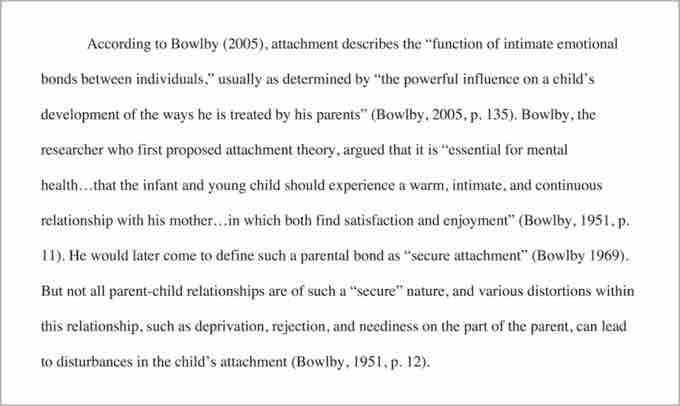In your paper, when you quote directly from a source in their words, or when you paraphrase someone else’s idea, you need to tell the reader what that source is so the author gets credit for their words and ideas. When you tell the reader the author’s name and the date the source was published in the text of your paper, this is called an in-text citation.

In-text citations
These in-text citations are properly formatted in APA style.
Source by a Single Author
To cite this type of reference in the text, you should use what is known as a parenthetical—the citation information enclosed in parentheses—at the end of the relevant sentence. The parenthetical should include the author’s last name (with no first or middle initial), followed by a comma, followed by the year the source was published. If you’re citing a direct quote, you also need to include the page number. For example:
- Social representations theory posits that reified scientific knowledge that exists at the boundaries of a given society will be interpreted in meaningful and often simplified forms by the majority (Pauling, 2005).
- Social representations theory “proposes a new hypothesis …” (Pauling, 2005, p. 113).
If you choose, you can integrate the author’s name into the sentence itself—this is known as a "signal phrase"—and provide just the year in parentheses:
- Pauling (2005) posits that ...
Source by Two Authors
Authors should be presented in the order in which they are listed on the published article. If you include the authors’ names in the parenthetical, use an ampersand (&) between the two names. For example:
- Social representations theory posits that reified scientific knowledge that exists at the boundaries of a given society will be interpreted in meaningful and often simplified forms by the majority (Pauling & Liu, 2005).
If you choose to use a signal phrase instead, use the word “and” rather than an ampersand:
- Pauling and Liu (2005) posit that ...
Source by Three to Five Authors
For an article with three to five authors, the first time you cite the article in the text of your paper, you should include the names of all the authors (in the same order in which they appear in the article) followed by the year of publication. After that, to save space and to make your paper easier to read, you should use only the first author’s name followed by “et al.” and the year of publication. (“Et al.” is short for “et alia,” which means “and other people” in Latin—much like “etc.” is short for “et cetera,” which means “and other things” in Latin.)
First Instance
- Social representations theory posits that reified scientific knowledge that exists at the boundaries of a given society will be interpreted in meaningful and often simplified forms by the majority (Pauling, Liu, & Guo, 2005).
Using a signal phrase:
- Pauling, Liu, and Guo (2005) posit ...
Subsequent Instances in the Same Document
- (Pauling et al., 2005)
Using a signal phrase:
- Pauling, et al. (2005) posit ...
Source by More than Five Authors
For an article with more than five authors, include only the first author's name followed by “et al.” and the year of publication in each in-text citation.
- (Hughes-Hallett et al., 2008)
Using a signal phrase:
- Hughes-Hallett et al. (2008) claim that ...
Multiple Publications by Different Authors
If you need to cite multiple publications by different authors in the same sentence, you should list the multiple sources in alphabetical order by author and use a semicolon to separate them.
- ... majority (Alford, 1995; Pauling, 2004; Sirkis, 2003).
If within this citation you also have multiple sources by the same author, after that author’s name separate the multiple dates of publication with a semicolon and order them chronologically (earliest to latest).
- ... majority (Alford, 1995; Pauling, 2004; 2005; Sirkis, 2003).
Multiple Publications by the Same Author
If an author has multiple publications which you wish to cite in the same sentence, you use a semi colon (;) to separate the years of publication in chronological order (oldest to most recent).
- ... majority (Pauling, 2004; 2005).
Using a signal phrase:
- Pauling (2004; 2005) suggests that ...
Multiple Publications by the Same Author/s in the Same Year
If multiple publications by the same author (or group of authors) were published in the same year, there is a special rule for denoting this. In the References section, you would order those articles alphabetically by source title, and then append a lowercase letter in alphabetical order to the end of the year of publication. For example, if you had two publications by Pauling in 2004, the first would be marked as (2004a) and the second as (2004b). You would then include these lowercase letters in your in-text citations as well:
- ... majority (Pauling, 2004a; 2004b).